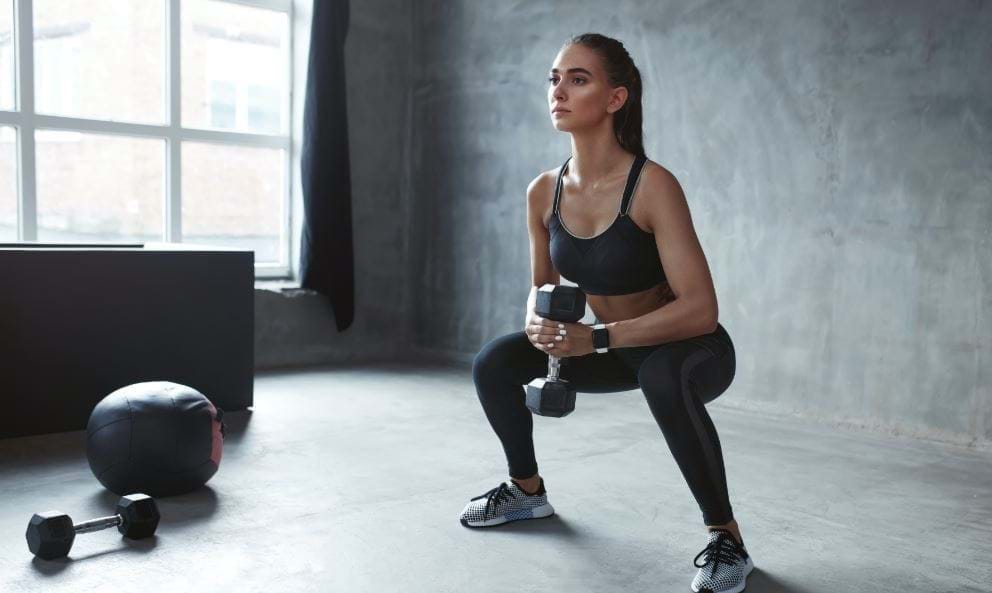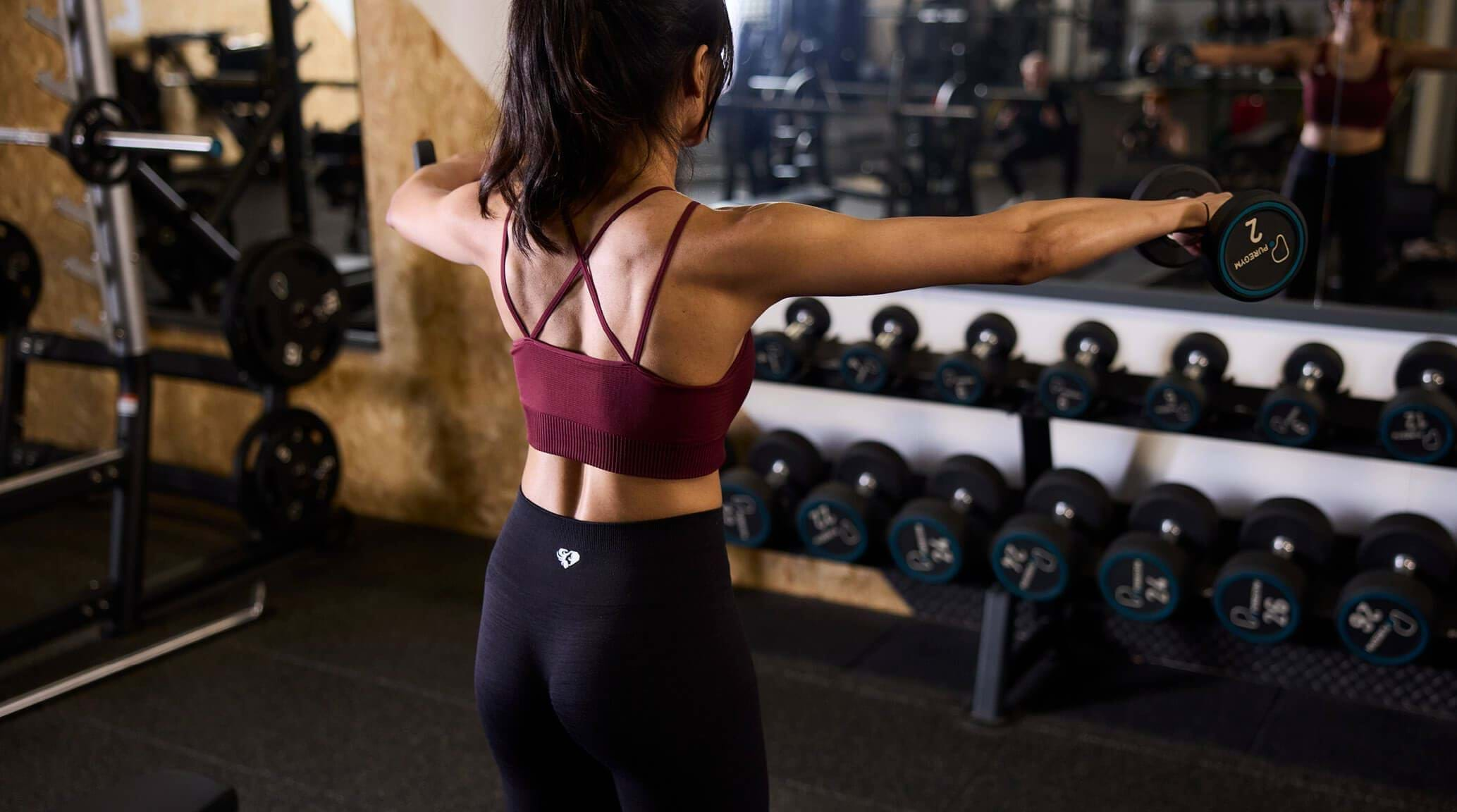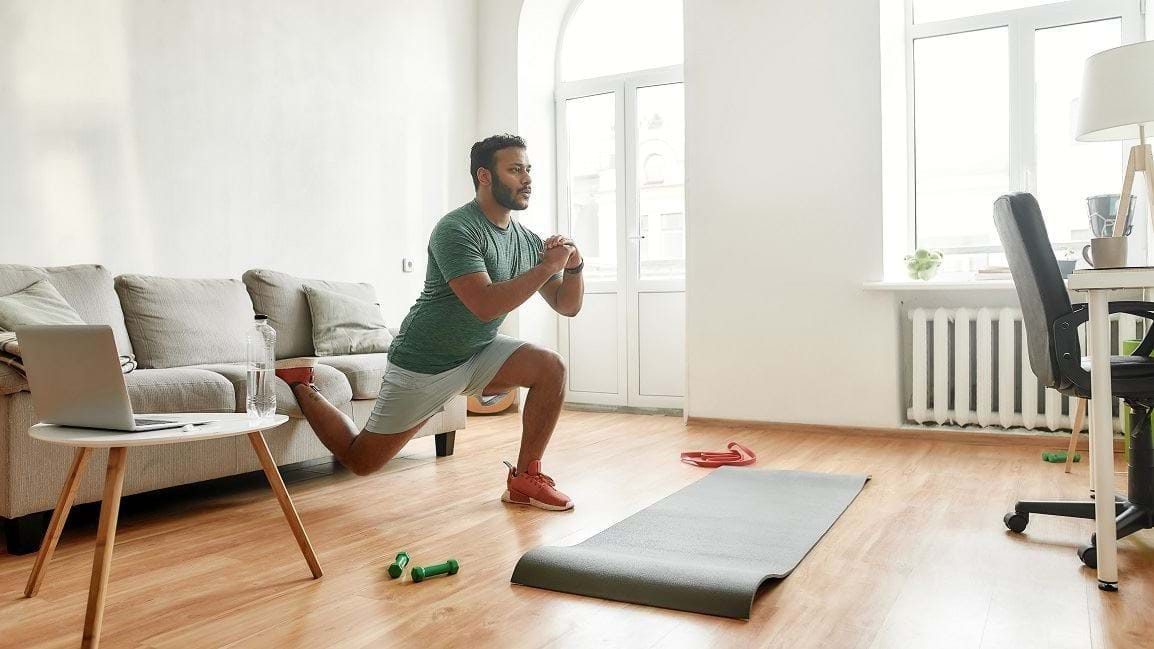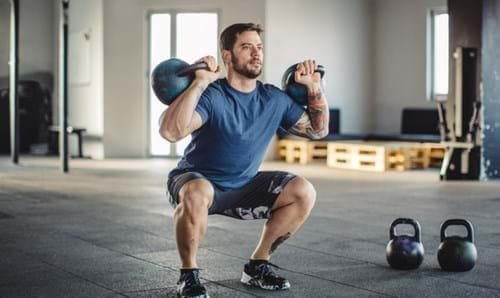HIIT Workouts With Weights

Including weights in a HIIT workout is one of the best ways to increase the challenge and maximize the effectiveness of the exercises. Below we explain what makes a weighted HIIT routine such a good workout option, and showcase some of our favorite moves for a workout that can include dumbbells, kettlebells, weighted plates and gym equipment.
WHAT IS A HIIT WORKOUT?
HIIT stands for High Intensity Interval Training - it's a training style that can be applied to a variety of different workouts, from cardio to weight training. It usually involves alternating periods of high intensity movements with periods of much lower intensity, or even rest periods. This approach means you're able to see the same results in a shorter time period as you would from a much longer, more regular-paced workout.
WHAT ARE THE BENEFITS OF HIIT WORKOUTS WITH WEIGHTS?
One of the reasons HIIT is so popular is that it's a really flexible style of training, meaning you can do HIIT workouts at the gym or at home, and if you don't have any equipment you can just focus on bodyweight exercises.
While bodyweight HIIT workouts can be a great way to increase your fitness, incorporating weights means you can push yourself further every week by increasing the weights. This can't be done using body weight alone, as once your body becomes accustomed to the resistance (your body weight), your progress and results can start to plateau and you will stop seeing progress.
Using weights, such as dumbbells, kettlebells (or even anything you have handy at home), within a HIIT workout is beneficial in many ways. It helps us to:
- Build muscle mass
- Build strength
- Burn calories more effectively than bodyweight HIIT or cardio
If you don't have any weights handy, then resistance bands can also be a good option, although these can't be progressed as easily as standard weights. Resistance bands are great for warming up and 'activating' the muscles prior to the main sessions, and can be a great way to strengthen and rehabilitate muscles, but people typically need to progress through to weights in order to challenge their muscles.
A WEIGHTED HIIT WORKOUT ROUTINE FOR YOU TO TRY:
Here's a selection of some of our favorite weighted exercises, which you can easily use for your next HIIT workout.
If you're able to easily switch between each piece of equipment, then you can create a circuit where you cycle through each movement once, and then repeat for three more sets. However, it's not always that easy to access each type of weight that quickly, so if it's easier, perform four sets of each exercise before moving on to the next one.
Depending on your skill level, you can increase or decrease the amount of high-intensity time, or sets you perform of each movement. For example, Tabata is one of the more full-on HIIT formats, with a lot of bursts of high intensity intervals and very short rests.
Remember, 'high intensity' means just that, high intensity, so really aim to give it your all in the time you're working without letting your form slip. Keep it speedy to really raise your heart rate.
As a guideline, we'd recommend:
- For beginner level - 40 seconds of high intensity followed by 20 seconds of rest, repeated for four sets of each exercise
- For intermediate level - 60 seconds of high intensity followed by 30 seconds of rest, repeated for four sets of each exercise
- For advanced level - 90 seconds of high intensity followed by 30 seconds of rest, repeated for four sets of each exercise (or you could lower to 20 seconds of high intensity, followed by 10 seconds of rest, repeated for eight sets of each exercise)
1. Kettlebell Swing
Kettlebell swings are an explosive movement that burn plenty of calories and really strengthen your glutes, hamstrings, core, shoulders and back.
- Stand with your back straight and feet shoulder-width apart, with the kettlebell on the floor just in front of you.
- Lower into a half-squat until you’re able to pick the kettlebell up with both hands.
- Grip so that your hands are facing your body.
- Engage your core and push through your heels to straighten your legs
- focus on an explosive movement through the hips to get maximum value from this movement.
- As you push up, use the momentum and your upper body to swing the kettlebell upwards to chest height.
- When the kettlebell drops back down between your legs, drop back down into the half-squat position. That's one rep.
Repeat for the required amount of time.
2. Walking Weighted Lunges
Ideal for targeting your lower body (covering your glutes, quads, hamstrings and calves) and also providing a strong core workout, there’s a range of lunges you can try to work a range of muscles. By adding weights to the lunge, you’ll be working those muscles even harder, while engaging your upper body and back muscles too.
- Stand straight with shoulders back and feet about shoulder-width apart.
- Hold a dumbbell in each hand at your sides, or a kettlebell with both hands in front of you at around chest height.
- Engage your core and take a big step forward with one leg.
- Bend your front knee until your thigh is parallel with the floor. Your back leg should be bent, with your shin parallel to the floor.
- Push through your front leg to return to standing.
- Alternate legs, repeating on the other side.
Repeat for the required amount of time.
3. Dumbbell Renegade Rows
Renegade rows are ideal for working your back, core and arm muscles, and are ideal for improving your balance and stability. Adding dumbbells boosts the challenge and is an excellent way to improve balance and stability.
- Start in a classic plank position and keep your shoulders positioned above your wrists. You’ll need to keep your legs spread wider than shoulder width apart.
- Take a dumbbell in each hand, while still keeping them on the floor. Make sure to focus on keeping your wrists strong, so you’re gripping the weight and leaning on the dumbbell rather than your hands.
- Shifting your weight to the left side of your body and making sure your core is engaged, pull your left elbow backwards (while still keeping it close to your body) and lift the dumbbell to around chest height.
- Your body should remain steady throughout this movement - your hips and shoulders should be square, with no rocking or twisting.
- Slowly lower to starting position before alternating to your right arm.
Repeat for the required amount of time.
4. Goblet Squats
Squats are a gym favorite - perfect for giving your glutes, core, and whole lower body a really good workout. While bodyweight squats are great, adding a dumbbell or kettlebell to the mix will help to increase the intensity (ideal for HIIT!) and give you a more challenging workout.
- Take your chosen weight with both hands and hold it close to your body at chest height, keeping your elbows tucked in towards your stomach.
- Same as with a regular bodyweight squat, stand tall with your shoulders back and feet slightly wider than hip-width distance apart, toes turned slightly out.
- Straighten your back and brace your abs. Sink your hips back and down towards the floor. As you do this movement, allow your elbows to drop between your legs, and inside your knees. Make sure that your knees don’t go over your toes while doing this movement by keeping the weight in your heels and focusing on your hips pulling backwards.
- When your hip sinks just below the knees, stay in this position for a brief pause, and then drive your hips back up towards the ceiling to return to standing position.
Repeat for the required amount of time.
5. Weighted Sled Pushes
The prowler sled is a piece of equipment you’ll find at the gym that provides an incredibly effective full body workout. You’ll feel the burn almost straight away, with pushes working your glutes, hips and back. It’s basically an iron sled, which you can load with the appropriate amount of weight and push along as hard and fast as you can for the allotted time. Just make sure to keep your core engaged and your shoulders back as you work.
TOP ADVICE FOR HIIT WORKOUTS WITH WEIGHTS:
- Start off easier and progress as time goes on. The worst thing is to go too hard at first and not be able to complete the whole session, leading to feelings of failure.
- Not all exercises have to be super intense - despite the ‘high intensity’ part of the name! You can incorporate ‘easier’ exercises within the working time to take a breather and refresh while still working hard throughout. You could also include a mix of weighted exercises like the ones above, and more cardio style HIIT like jumping jacks or burpees.
- Make sure you rest and recover well after and between each session, as they are intense. Avoid going overboard as you could end up with an injury or burnout.
- Stick to a plan each week that allows you to progress. Make sure the exercises are the same if not very similar each week to allow your body to build and progress.
- Give it a go! If you don’t like it, then don’t do it anymore, find something else you love. If you love it, great! Enjoy every minute of it!


